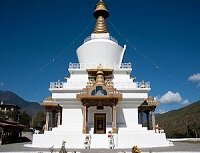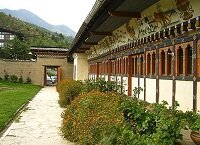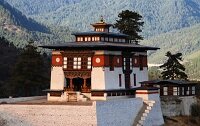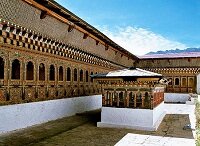Thimphu is a bustling town on the bank of Thimphu Chu & set gloriously in the hills of the Thimphu valley. Thimphu is the capital of Bhutan and it is the centre of Government. It is situated in the western central part of Bhutan and the name of the surrounding valley is Dzongkhag, the Thimphu District. The city became the capital of Bhutan in 1961.
The name ‘Thimpu’ originates from a sinking stone in front of Dechenphu monastery. ‘Thimpu’ means to sink and ‘phu’ meaning to fly in local language. Oral history says that the stone is placed on top of a subdued ogress to prevent her from flying away.
It has an interesting combination of tradition and modernity, and includes some of the most advanced and remotest parts of the kingdom. It is the home of the Bhutanese Royal family, Civil servants & Expatriates.
The culture of Bhutan is fully reflected in Thimphu in respect of literature, religion, customs, and national dress code, the monastic practices of the monasteries, music, dance, literature and in the media. Tsechu festival is an important festival when mask dances, popularly known as Cham dances, are performed in the courtyards of the TashichhoeDzong in Thimphu.
Roam Around ........
Memorial Chorten: The Memorial Chorten, also known as the Thimphu Chorten, situated in the centre of ThimphuCity. The chorten, built in 1974 to the honour of 3rd King of Bhutan, is a prominent landmark in the city with its golden spires and bells. It is popularly known as "the most visible religious landmark in Bhutan".
Changangkha Monastery: ChangangkhaLhakhang is one of the oldest monasteries in the Thimphu valley. It was built in the 15th century by a descendant of Lama Phajo, the man who spread the sect drukpakagyu in Bhutan. The main statue at the temple is of Avalokiteswara (the eleven-headed Buddha manifestation with 1000 arms and 1000 eyes). The temple courtyard offers good views over the city of Thimphu.
Simtokha Dzong: SimtokhaDzong, known as SangakZabdhonPhodrang (Palace of the Profound Meaning of Secret Mantras) is said to be the oldest surviving fortress cum monastery established in 1629 by ZhabdrungNgawangNamgyal, who unified Bhutan. It was attacked several times in the 17th century but survived and was refurbished repeatedly. It is a small dzong (only 60 metres (200 ft) square with gate on the southern direction), located about 5 kilometres to the south of Thimphu. It now houses one of the premier Dzongkha language learning institutes namely, "The Institute for Language and Culture Studies." Both monks and common people study here. Students who graduate from this school primarily become Dzongkha teachers.
National Zoo: Contains national animal Takin. The Takin is a goat-antelope found in the Eastern Himalayas. Bhutan selected the Takin as the national animal based on both its uniqueness and its strong association with the country's religious history and mythology.
National Library: The National Library was established in 1967 to preserve many ancient Dzongkha and Tibetan texts. (9am – 4pm, Closed on Sunday, Monday & National Holidays)
BBS Tower: It is located North West of the ThimphuValley. The Places has the top hill which gives a clear view of the entire Thimphu valley in a nutshell and the feeling from there is just fantastic.
 Folk Heritage Museum: The house replicates a traditional farmhouse and is furnished as it would have been about a century ago. A guided tour of this almost-living museum is included in the admission and provides a glimpse into traditional Bhutanese life. The house design and many of the implements are also reminders of how many rural Bhutanese still live today. Bring a torch (flashlight) as some of the rooms are quite dimly lit.
Folk Heritage Museum: The house replicates a traditional farmhouse and is furnished as it would have been about a century ago. A guided tour of this almost-living museum is included in the admission and provides a glimpse into traditional Bhutanese life. The house design and many of the implements are also reminders of how many rural Bhutanese still live today. Bring a torch (flashlight) as some of the rooms are quite dimly lit.
National Textile Museum: This museum is worth a visit to get to know the living national art of weaving. Exhibitions introduce the major weaving techniques, styles of local dress and textiles made by Bhutanese. (Everyday 9am – 4pm & Saturday 1pm – 4pm, Sunday 10am – 3pm, Closed on Monday & National Holidays)
School of Arts And Crafts: The School of Arts and Crafts, commonly known as painting school, offers an eight year course which provides instruction in many of Bhutan's traditional arts to boys throughout the country. (Everyday 2pm – 4pm & Saturday 9am – 12noon, Closed on Sunday & National Holidays)
National Institute of Traditional Medicine: This institute was established in 1978. It prepares and dispenses traditional herbal and other medicines. There is an impressive laboratory and production facility that manufactures quality products. All kinds of pills, tablets, ointments and medicinal teas from here are distributed to regional health-care units around the country.
Jungshi Handmade Paper Factory: This small factory produces watermark paper as well as cards, lampshades, envelopes, calendars and other items made from traditional Bhutanese paper.
Tashichho Dzong: TashichhoDzong, "Fortress of the Glorious Religion", is the most stately and most impressive building in Bhutan. The dzong housed the original National Assembly and now houses the secretariat throne room and the offices of the King of Bhutan. Visit to TashichhoDzong permitted only after office hours (4pm – 5pm) in winter months when the monk body is not in Thimphu.
Weekend Market: Every Saturday & Sunday most of the Thimphu population congregate on the banks of the river, where the weekend market is held. Here villagers from the valley & other nearby places come to sale their agricultural products.
 Dechen Phodrang Monastery: DechenPhrodrang means "Palace of Great Bliss." It is a Buddhist monastery located to the north of Thimphu. The Dzong located at the end of Gaden Lam was originally the site of Thimphu's original TashichhoeDzong. In 1971, it was converted into a monastic school with 450 student monks enrolled for eight-year courses. It has a staff of 15.The monastery contains a number of important historical Bhutanese artifacts including 12th century paintings monitored by UNESCO and a noted statue of Namgyal on the upper floor. In the downstairs chapel, there is a central SakyamuniBuddha.
Dechen Phodrang Monastery: DechenPhrodrang means "Palace of Great Bliss." It is a Buddhist monastery located to the north of Thimphu. The Dzong located at the end of Gaden Lam was originally the site of Thimphu's original TashichhoeDzong. In 1971, it was converted into a monastic school with 450 student monks enrolled for eight-year courses. It has a staff of 15.The monastery contains a number of important historical Bhutanese artifacts including 12th century paintings monitored by UNESCO and a noted statue of Namgyal on the upper floor. In the downstairs chapel, there is a central SakyamuniBuddha.
Dechencholing Palace: Dechencholing Palace is located to the northern end of the Thimphu valley on the east bank of the ThimphuChuu. It was the residence of the late Royal Grandmother, popularly known as GayumPhuntshoChodenWangchuck. King JigmeSingyeWangchuck was born here on 11 November 1955, but currently makes his residence at the Samteling Palace (Royal Cottage). The palace is frequently used for international delegations, especially those with India. Indian ambassadors regularly visit the palace to discuss international relations between India and Bhutan. It is also the venue for hosting luncheons and banquets for Head of the States and other important guests of Bhutan
Cheri Monastery: Cheri Monastery also called ChagriDorjeden Monastery was established in 1620 by ZhabdrungNgawangNamgyal; the first monastery established by him at a young age of 27. Zhabdrung spent three years in strict retreat at Chagri and resided there for many periods throughout the rest of his life. It was at Chagri in 1623 that he established the first Drukpa Kagyu monastic order in Bhutan. The monastery, which is now a major teaching and retreat centre of the Southern Drukpa Kagyu order, is located at the northern end of ThimphuValley, about 15 kilometres (9.3 mi) from the capital. It sits on a hill above the end of the road at Dodeyna and it takes about an hour's walk up the steep hill to reach the monastery from there. According to Bhutanese religious histories, the place was first visited by Padmasambhava in the 8th century. In the 13th century, it was visited by PhajoDrugomZhigpo, the Tibetan Lama who first established the Drukpa Kagyu tradition in Bhutan. There is a silver chorten inside the monastery that enshrines the ashes of Zhabdrung's father.
 Tango Monastery: The Tango Monastery is located to the north of Thimphu near Cheri Mountain. It was founded by Lama GyalwaLhanampa in the 13th century and built in its present form by Tenzin Rabgye, the 4th Temporal Ruler in 1688. According to local legend, the location of this monastery is the holy place where Avalokiteshvara revealed himself as "the self-emanated form of the Wrathful Hayagriva". The location had been prophesised in Tibet. In 1616, the Tibetan, ShabdrungNgawangNamgyal, meditated in its cave. It belongs to the Drukpa KagyuSchool of Buddhism in Bhutan. The word 'Tango' in Bhutanese language means "horse head". This name conforms to the main deity Hayagriva (local name Tandin) deified in the monastery. Tango Monastery is built in the dzong fashion, and has a curved (semi-circular) outside wall and prominent main tower with recesses. It covers the caves where originally meditation and miracles were performed by saints from the 12th century onwards Behind the series of prayer wheels are engraved slates. Inside the courtyard is a gallery, illustrating the leaders of the Drukpa Kagyupa lineage.
Tango Monastery: The Tango Monastery is located to the north of Thimphu near Cheri Mountain. It was founded by Lama GyalwaLhanampa in the 13th century and built in its present form by Tenzin Rabgye, the 4th Temporal Ruler in 1688. According to local legend, the location of this monastery is the holy place where Avalokiteshvara revealed himself as "the self-emanated form of the Wrathful Hayagriva". The location had been prophesised in Tibet. In 1616, the Tibetan, ShabdrungNgawangNamgyal, meditated in its cave. It belongs to the Drukpa KagyuSchool of Buddhism in Bhutan. The word 'Tango' in Bhutanese language means "horse head". This name conforms to the main deity Hayagriva (local name Tandin) deified in the monastery. Tango Monastery is built in the dzong fashion, and has a curved (semi-circular) outside wall and prominent main tower with recesses. It covers the caves where originally meditation and miracles were performed by saints from the 12th century onwards Behind the series of prayer wheels are engraved slates. Inside the courtyard is a gallery, illustrating the leaders of the Drukpa Kagyupa lineage.
Buddha Dordenma: The Buddha Dordenma is a bronze statue, a 'Vajra Throne' Buddha, that is under construction amidst the ruins of KuenselPhodrang, overlooking Thimphu city, about 100 metres (330 ft) above the Wang Chuu river bed. This location was the palace of SherabWangchuck, the 13th DesiDruk. It is a gigantic Shakyamuni Buddha statue under construction. The statue will house over one lakh (one hundred thousand) smaller Buddha statues, each of which, like the Buddha Dordenma itself, will be made of bronze and gilded in gold. Upon completion, it will be one of the largest Buddha rupas in the world, at a height of 51.5 metres (169 ft). The statue alone is being built at a cost of US$47 million, by Aerosun Corporation of Nanjing, China, while the total cost of the Buddha Dordenma Project is well over US$100 million.The interior will accommodate 100,000 8-inch-tall and 25,000 12-inch-tall gilded Buddhas respectively. It is planned to be completed by October 2010 Apart from commemorating the centennial of the Bhutanese monarchy, it fulfils two prophecies. In the 20th century, the renowned yogi SonamZangpo prophesied that a large statue of either Padmasambhava, Buddha or of a phurba would be built in the region "to bestow blessings, peace and happiness on the whole world". Additionally the statue is mentioned in the ancient terma of Guru Padmasambhava himself, said to date from approximately the 8th century, and recovered some 800 years ago by tertonPemaLingpa.
Motithang Takin Preserve: Thimphu is a wildlife reserve area for takin, the National Animal of Bhutan. Originally a mini-zoo, it was converted into a preserve when it was discovered that the animals refrained from inhabiting the surrounding forest even when set free. The reason for declaring the takin as a National Animal of Bhutan on 25 November 2005 (Budorcastaxicolor) is attributed to a legend of the animal's creation in Bhutan in the 15th century by Lama DrukpaKunley. The King of Bhutan believed that it was improper for a Buddhist country to confine animals for religious and environmental reasons, so he ordered the closure of the mini-zoo and the release of the animals into the forest. However, the Takin remained rooted to the town and were seen straying in the streets of Thimphu in search of fodder. Hence, an exclusive preserve was created for them to live freely.
Zangtho Pelri Lhkhang: This lhkhang was built in 1990s by DashiAkuTongmi, who was a great musician . The lhkhang is a replica of Guru Rinpoche’s cel;estial abode. The chapel is located just next to the lower market , popularly known as Sabji – Bazaar.